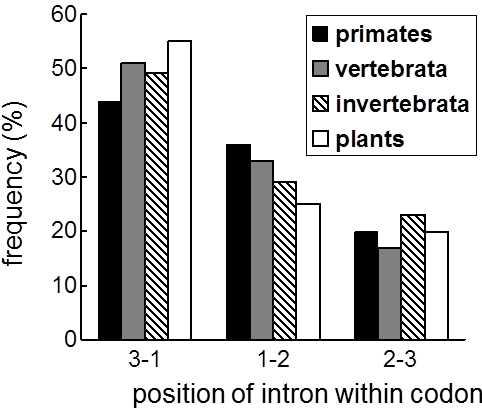XI.7.2.2 The presence of introns in its genes can enhance an organism’s evolutionary potential
According to this hypothesis, the presence of introns increases the evolutionary potential of an organism and their origin could even be directly connected with the origin and evolution of eukaryotes.The hypothesis assumes that the favorable effect of introns on the rate of evolution led, not only to enormous adaptive radiation of eukaryotes, but also to the origin of multicellular organisms.
Introns are not distributed arbitrarily in genes; with substantially greater probability they separate the individual structural and thus functional domains of future proteins (Desouza et al. 1996; Gilbert, Desouza, & Long 1997).It is assumed that the resultant modular character of genes can thus substantially accelerate the origin and evolution of new proteins during gene recombination.The genes for new proteins can be formed by combination of exons that encode the already functional part of proteins.Consequently, the products of this recombination can frequently be functional.If the genes did not contain introns and the recombination were to occur at an arbitrary site, for example, inside an area encoding a certain domain, it would be highly probable that the resultant product of recombination between two different genes would be nonfunctional.However, if the individual functional domains of the future protein are encoded by independent exons, separated by long intron sections, it is more probable that recombination between two different genes would occur just in the area of the introns, so that the resultant gene, following splicing of the introns, would encode a protein formed by a new combination of completely functional and undisturbed domains.The effectiveness of this process is also assisted by the fact that, amongst introns, there is a statistical predominance of those that are inserted between 2 triplets and not those that are inserted inside a triplet (Tomita, Shimizu, & Brutlag 1996, de Souza 2003)(Fig. XI.7).As a consequence, the risk of a reading-frame shift during recombination is reduced.

Fig. XI.7 Locations of introns in the genes in various codon positions. In all the studied taxons, the greatest numbers of introns are inserted between the individual codons, i.e. in 3-1 positions. This is followed by location between the first and second base of the codon, while introns located between the second and third codon base are least common. According to Tomita et al. (1996).
